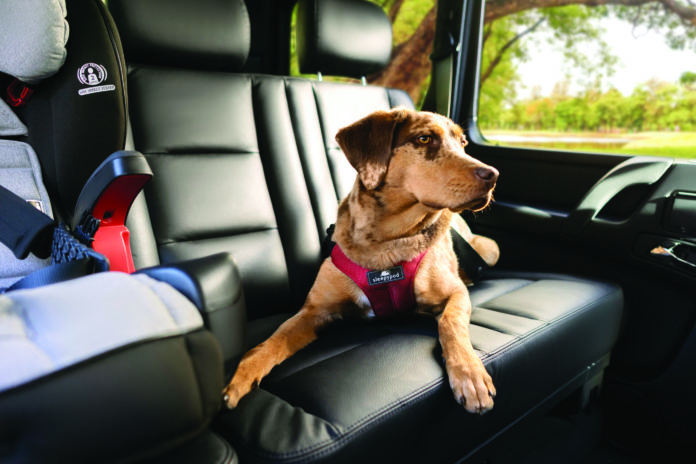How to help your pup with separation anxiety

Separation anxiety is on the rise with many pet owners returning to work. Here are some tips on how to help your pup stay calm while you’re away.
Separation anxiety in dogs was on the rise pre-pandemic and today is likely the most common behavior problem. As some are dashing back to the office, no one is giving adopted “pandemic puppies” a heads up in advance; the sudden change has begun to manifest in even more reports of separation anxiety.
What is separation anxiety?
Separation anxiety is essentially a panic attack. As dogs suffer, sometimes so do neighbors. Weary of the barking, landlords or condo associations can lose patience. It’s a myth that most adopted dogs come with a leash, collar and separation anxiety. It’s not a myth that many dogs are relinquished to shelters because of separation anxiety. And this is tragic because dogs can be treated.
Cameras reveal secrets of what the dogs are doing, and the best tool to diagnose. Also, toss treats about as you leave the house and see if they are scarfed up before you return (a food motivated dog that’s anxious likely won’t eat).
/* custom css */
.tdi_15.td-a-rec{
text-align: center;
}.tdi_15 .td-element-style{
z-index: -1;
}.tdi_15.td-a-rec-img{
text-align: left;
}.tdi_15.td-a-rec-img img{
margin: 0 auto 0 0;
}@media (max-width: 767px) {
.tdi_15.td-a-rec-img {
text-align: center;
}
}
Here are signs of distress to watch for:
- Vocalizing
- Watchful waiting
- Destruction, chewing walls, furniture, scratching at doors, etc.
- Escape attempts
- Accidents (in dogs reliably house-trained)
- Excessive panting (unrelated to heat)
- Hypersalivation
- Pacing
- Self-harm
Too many simply look at the above check list, go to the Internet and decide “my dog has separation anxiety.” Would you play doctor and diagnose your dog with diabetes or hypothyroid disease? Likely not. Some dogs exhibiting signs bulleted above may be bored, under-exercised, haven’t been taught how to be home alone or bark because it’s fun. A veterinary professional can view video, ask questions, and make a diagnosis.
Here’s what doesn’t work – doing nothing. Never think that the dog will figure it out, that everyone’s coming home. In fact, early intervention is best.
Ways to combat canine separation anxiety
When a dog is diagnosed, a veterinary behaviorist, certified dog behavior consultant or dog trainer with a Separation Anxiety Certificate can offer advice but only a veterinarian can provide a pharmaceutical.
While some pet parents may be concerned about their dog being “zoned” out on a drug, given the correct dosage that rarely occurs. Behavior modification works to teach dogs how to stay home alone, but that can’t be accomplished when dogs are panicked. Pharmaceuticals are often the most humane alternative, normalizing brain chemistry, which makes learning possible.
Reconcile (fluoxetine hydrochloride) is an FDA-approved medication for the treatment of canine separation anxiety in conjunction with behavior modification training. Reconcile is a once-a-day flavored, chewable tablet prescribed by your veterinarian. Reconcile achieves a calmer frame of mind in dogs, so they’re receptive to training. There are other faster acting drugs which may be used as Reconcile may take over a month to truly kick in.
That training can include:
- Teaching dogs to comfortably relax in another room, achieving some independence. Of course, saying “hi” to dogs when you come home is natural, but some people are more dramatic and exuberant than their dogs – tone it down a notch.
- Eliminate departure cues. Some dogs know hours in advance when their people are headed out and are nervous wrecks well before their people leave. These cues can be eliminated by offering dogs an alternative behavior (if the pup is playing, being simultaneously anxious is unlikely). Also, practice graduated departures, leaving home for moments at a time and calmly returning, and gradually building up to longer and longer periods away. While this behavior modification is being practiced, it might be a good idea to hire a dog walker to break up long days.
Meanwhile, there are host of adjunct products which can further take off the edge, nutraceuticals (hybrid of a nutritional supplement and pharmaceutical), pheromones, wearables (such as the Thundershirt), or the Calmer Canine which uses electromagnetic energy to reduce neuro-inflammation in the anxious brain. Relaxing music can relax dogs too.
The good news is that today there are a myriad of products and tools available, and expertise to offer advise on how to implement these.
Important Safety Information:
The most common adverse events in decreasing order of reported frequency are: decreased appetite, depression/lethargy, shaking/shivering/tremor, vomiting, restlessness and anxiety, seizures, aggression, diarrhea, mydriasis, vocalization, weight loss, panting, confusion, incoordination, and hypersalivation.
Reconcile® chewable tablets are contraindicated for dogs with a history of seizures or when used with MAOIs. Reconcile chewable tablets are indicated for the treatment of canine separation anxiety in conjunction with a behavior modification plan. Federal law restricts this drug to use by or on the order of a licensed veterinarian. Visit Reconcile.com to view full prescribing information.

/* custom css */
.tdi_16.td-a-rec{
text-align: center;
}.tdi_16 .td-element-style{
z-index: -1;
}.tdi_16.td-a-rec-img{
text-align: left;
}.tdi_16.td-a-rec-img img{
margin: 0 auto 0 0;
}@media (max-width: 767px) {
.tdi_16.td-a-rec-img {
text-align: center;
}
}



